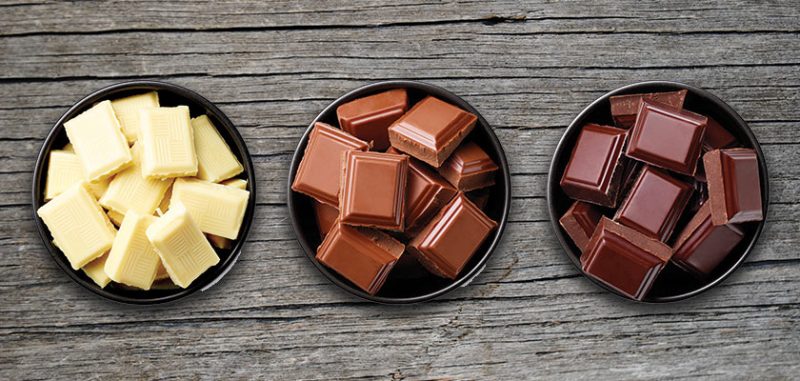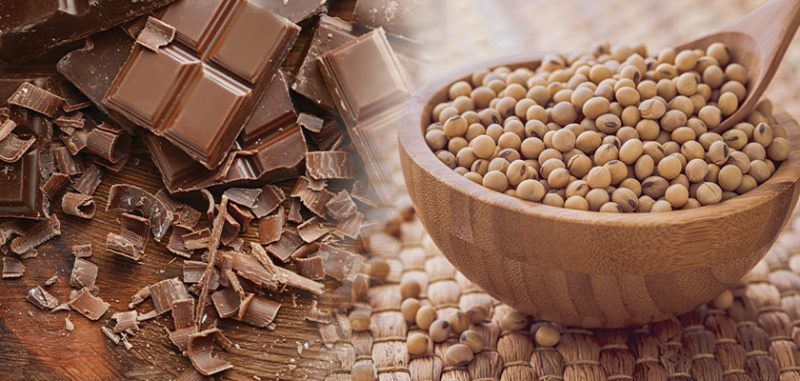As a chocolate-maker, chocolatier or baker, you may feel overwhelmed by the various chocolate types out there. Food scientist Elily Temam clears the confusion and explains the difference between milk chocolate vs dark bittersweet and semisweet vs white chocolate, and more.
Chocolate is a beautiful thing, but trying to make sense of all the labelling can be a bit of a challenge, and trying to decide which one is best for your task is even more confusing. Like many ingredients, such as flour for instance, the best chocolate for the job depends on the application. In this article, food scientist and avid chocolate lover Elily discusses all the different chocolate types and labels you are likely to come across, their best application, and a side-by-side comparison of the major types. Let’s hand over to her now.
Chocolate Types & Comparisons
Written by Elily Temam
Chocolate comes from one source but it has different types within it. I’m fairly certain that you have heard of at least these three types; dark chocolate, milk chocolate, and white chocolate these are the main ones. In this article you will be introduced to the different types of chocolate that are used and beloved in the chocolate world. Let’s get started!
What is The Difference Between Milk Chocolate vs Dark vs White
Dark Chocolate
Dark chocolate is known for being the umbrella term for the two chocolate that are a friend to every brownie lover, them being; bitter sweet and semi-sweet chocolate. It’s a dark brown color. It is a form of chocolate that contains no dairy product and is known for having from 50 up to 90% cocoa solids and a sweetener, depending on the amount of sweetener used its name varies between bitter and semi-sweet.
The difference between semisweet and bittersweet chocolate is:
- Semi-Sweet Chocolate: Semi-sweet chocolate is a type dark chocolate. It is the proportional combination of cocoa solids, sweeteners and cocoa butter altogether. The government standards that are set for this type of chocolate are: 35% chocolate solid, an average 27% of fat, and a sugar content not greater than 50%. So, when you want to purchase semi-sweet chocolate next time check its percentage and make sure the cocoa solid is the right amount.
- Bitter-Sweet Chocolate: This is another type of dark chocolate that is more bitter than it is sweet. It gives a good balance of these two flavors. The cocoa solid ranges from 50 to 80% and 10 to 50% of it is sugar. This chocolate is enjoyed by hardcore chocolate lovers that enjoy the acidic taste.
Dark chocolate has an acidic taste with a hint of sweetness. The ingredients that are mainly used in the making of dark chocolate are; cacao solid, sugar, an emulsifier like soy lecithin, and sometimes flavorant like vanilla. Dark chocolate is the perfect snack for vegans and a nice treat for people with lactose intolerance, and it is also a good source of flavanols and different minerals. Since it contains no dairy products, it is firmer in texture than milk chocolate, which gives it a good snap which is music to every chocolatier’s ears. It is the perfect addition to any dessert.
Milk Chocolate
What’s the difference between milk chocolate vs dark chocolate? Milk chocolate is a slightly modified version of dark chocolate, it is a great option when all you want from your chocolate is a sweet, creamy goodness. Milk chocolate is made from cocoa solids, sugar and milk products, not including fermented milk products, of course. They have a lower cocoa solid content than dark chocolate, since the increased cocoa solid is what gives chocolate its acidic taste, milk chocolate is free from that acidity. So, for recipes where you need a sweeter chocolate, milk chocolate is the best option.
White Chocolate
Ok then, what is the difference between white chocolate and milk chocolate? The age-old argument in the chocolate world is whether or not white chocolate is considered as real chocolate; this is due to the fact that it contains no cocoa solids and therefore doesn’t satisfy the criteria’s to be considered a chocolate. But, I’m not here to start an argument rather to help you get to know white chocolate. According to the FDA to be considered as a white chocolate, it must contain 20% of cocoa butter, 14% total milk solids and 3.5% of milk fat. White chocolate tends to be on the sweeter side compared to other chocolate types this makes it the perfect pairing with fruits such as strawberries.

Milk Chocolate vs Dark Chocolate
| Dark Chocolate | Milk Chocolate |
| Has 50-90% of cocoa solids Contains no milk products Doesn’t have a creamy texture and is less sweet | Has up to 50% of cocoa solids Contains milk product Has a creamier texture Is sweeter |
White Chocolate versus Milk Chocolate
| White Chocolate | Milk Chocolate |
| 0% Cocoa Solids Although it is made from sugar, cocoa butter, milk and flavorant, which are the same ingredients used in milk chocolate it misses a key ingredient which is cocoa solids. | <50% Cocoa Solids Milk chocolate contains up to 50% of cocoa solids which gives it its brown color. |
Other Chocolate Types and their Applications
Couverture Chocolate
This chocolate is the one you see in a lot of recipes that require you coat or dip your sweets. Its name comes from a French word and it means “to cover” or “to blanket.” What makes couverture chocolate different is that it contains more cocoa butter. According to Europe and US standards, couverture contains around 35% cocoa solids and at least 31% of cocoa butter. The large cocoa butter percentage gives it a glossy look and a good snap. This chocolate requires it to be properly tempered before use.
Unsweetened Chocolate
This type of chocolate is 100% cacao with no added sweetener. It is made from cacao solids and cocoa butter. According to the FDA the cocoa butter percentage is approximately 50% and the remaining percentage is filled with cocoa solids. This type of chocolate is not the type that you can snack on. It was created for the sole purpose of baking and its flavor can be adjusted in accordance with the sweetness level required in the recipe. It provides a deep chocolatey flavor to dessert it is added in.
Raw Chocolate
This type of chocolate is called raw not because it is consumed without any processing but because it is roasted at a lower temperature than the other types of chocolates, supposedly around 40 to 45oC (104oF- 113oF). It is believed that its nutritional value is better because of the low processing temperature. This type of chocolate is used in paleo desserts.
Ruby Chocolate
This chocolate is known for having a pinkish color and berry flavor, ruby chocolate is a particularly new type of chocolate. This color is caused due to the natural color of the beans. This type of cacao pods are grown in Brazil, Ecuador and Ivory- coast. It is slightly similar to white chocolate in its creaminess but it contains cocoa solids.
Cocoa Nibs
Cocoa nibs are crushed up cacao beans after the beans are dried, fermented and sometimes roasted. They are not altered from their natural form in a any way in a sense of adding or enhancing their flavor, they are served in their purest form with minimum processing to develop that intense chocolate flavor. Cacao nibs are not technically chocolate yet, but you can use cacao nibs to make chocolate as instructed in this article.
Comparison of Different Chocolate Types
Now that you have gotten a little familiar with the types of chocolates that exist, you might be wondering what difference exists between some of the chocolate types and which one you can use for your different baking escapades, lets delve in.
| Milk | White | Dark Semi-Sweet | Dark Bitter-Sweet | Unsweetened | |
| Cocoa Solids | <50% | 0 | ~35% | 50-80% | ~50% |
| Milk Solids | Yes | Yes | No | No | No |
| Texture | Creamy | Creamy | Hard | Hard | Hard |
| Flavor | Sweet | Sweet | Somewhat Bitter | Very Bitter | Very Bitter |
| Sugar | Lots | Lots | Some | Little | None |
Bittersweet vs Semi Sweet Chocolate
These two are categorized under dark chocolate, let’s find out what sets them apart from each other. these two types of chocolate can be a substitute for one another in recipes.
| Semi-sweet chocolate | Bitter sweet chocolate |
| MORE SWEET Around 35% cocoa solids (it’s more on the sweet side) It has a mellow flavor with less acidic undertone | MORE BITTER 50 to 80% of cocoa solids (makes it more bitter than sweet) It has an intense flavor with a more acidic undertone |
Difference between Semisweet and Milk Chocolate
Since semisweet chocolate is a sweeter variation of dark chocolate, you might be wondering if there is a significant difference between semisweet and milk chocolate. The key difference is that semisweet dark chocolate does not contain any milk solids and is generally less sweet compared with milk.
| Semi-Sweet Chocolate | Milk Chocolate |
| Contains no milk products Contains around 35% cocoa solids More bitter in flavor Doesn’t have much of a creamy mouthfeel Doesn’t melt quickly | Contains milk products Contains about 10-50% cocoa solids Has a sweet flavor Creamy mouthfeel Melts quickly |
Unsweetened vs Bittersweet Chocolate
| Unsweetened Chocolate | Bitter-Sweet Chocolate |
| 50% cocoa solids Contains no added sugar Contains about 50% cocoa butter | 50-80% cocoa solids Contains some sugar Cocoa butter content varies from one manufacturer to another |
Although the FDA regulation on what percentage of the ingredients should be present in each chocolate types is specified, the taste still varies from one manufacturer to another, this can be due to several different reasons which I won’t bore you with; but they still satisfy the expectations we have from the chocolates and that is what matters.
Final Thoughts on Milk Chocolate vs Dark vs White Chocolate
We hope you’ve enjoyed Elily’s discussion on the difference between the difference on the various chocolate types available, and learnt he key difference between milk chocolate vs dark chocolate vs white. The key difference between each lies in the balance of cocoa solids, sugar, cocoa butter and whether or not it contains milk powder.
A quick summary is below:
- Milk Chocolate is very sweet, contains milk powder and has a creamy melt-in-the-mouth feel. Best for eating and sweet cooking.
- White Chocolate does not contain any cocoa solids at all, it is very sweet and creamy.
- Dark Chocolate comes in semi-sweet or bitter-sweet, with semi-sweet being more sweet and bitter-sweet being more bitter. They can be substituted for each other, and are best for rich baking.
…and for the other types including unsweetened, couverture and raw just scroll up and have a read. To learn more about the production process of these chocolates and how cocoa influences the flavor, we also suggest you check out the factory process for manufacturing chocolate and the art and science of choosing cocoa beans for chocolate making. Equipped with this knowledge, you should be well on your way to choosing and using the right chocolate for the job!
Happy chocolatiering!








